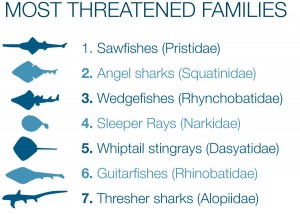The conservation of elasmobranchs- sharks, rays, and skates- has become an important topic of conversation worldwide. The increasing amount of research going into these ancient lineages of fish tells us of their powerful, finely tuned predatory forms, their sometimes surprisingly complex behaviors, and their hidden ability to sense electric fields to hunt their prey.
However, research also paints a story of animals that mature very slowly and have very few young at a time once they reach the age of reproduction. This makes them vulnerable to disturbances in their populations or habitats.
The IUCN estimated in 2014 that a full 24% of all shark, ray and skate species are vulnerable, endangered or critically endangered per the IUCN’s Red List. Most of this risk is due to fishing pressure, either through bycatch or direct exploitation, or habitat destruction, such as in the case of sawfish.
 Figure from the open access paper of Dulvy et al, 2014.
Figure from the open access paper of Dulvy et al, 2014.
When we talk about saving elasmobranchs, we often focus on familiar species and families, like the great white shark, hammerheads, manta rays, and whale sharks. This means that the more critically endangered families such as sawsharks, sleeper rays, and thresher sharks get significantly less attention, even as the charismatic groups show some recovery.
There’s been a justifiable outcry about shark finning, wherein a shark is removed from the water, and its valuable fins, used for shark fin soup, are cut from its body before it is thrown back into the sea. By and large, this has been the fate of sharks that are accidentally or purposefully caught.
However, shark scientists like David Shiffman argue that conservation initiatives focus too much on the way a shark is killed, as opposed to the fact that sharks are being unsustainably harvested, period. This means trends independent of the fin trade, like the increasing capture of sharks and rays for their meat, and other messy parts of shark conservation, are being ignored in favour of a flashy issue.
On top of that, some of the U.S. based shark finning regulations championed by conservation groups ironically lack teeth, leaving gaping loopholes that allow for many species of dogfish to continue being exploited without regulation, essentially making the legislation useless.
What does this all mean? To me, it seems like we’ve finally hit the point where people care about cartilaginous fish- and now we’ve applied the “charismatic megafauna” treatment to them. But not all sharks are the apex predators of our nightmares: some are lower in the food web, and even are prey for other sharks. All of them are important for our ecosystems in some way or another. We have to move away from the “popular” species and sensationalistic issues that don’t address the core threats sharks face. We’ve gotta give some love to the lesser-known, identify and help the species most at risk, even if they’re not as pretty- and count our victories where they happen, too.
References:
Dulvy, N. K., Fowler, S. L., Musick, J. A., Cavanagh, R. D., Kyne, P. M., Harrison, L. R., Carlson, Davisdson, L. N. K., Fordham, S., Francis, M. P., Pollock, C. M., Simpfendorfer, C. A.,Burgess, G. H., Carpenter, K. E., Compagno, L. V. J., Ebert, D. A., Gibson, C., Heupel, M. R., Livingstone, S. R., Sanciangco, J. C., Stevens, J. D., Valenti, S., and White, W. T. (2014). Extinction risk and conservation of the world’s sharks and rays. eLife 3:e00590.
FAO, (2015). State of the global market for shark products. FAO Fisheries and Aquaculture Technical Paper. [online] FAO, p.196. Available at: http://www.fao.org/3/a-i4795e.pdf [Accessed 15 Oct. 2015].
Guilford, G. (2014). New York’s ban on the illegal shark-fin trade won’t do much to protect sharks. The Sea. [online] Quartz. Available at: http://qz.com/109052 [Accessed 15 Oct. 2015]
Harrison, L. R., and Dulvy, N. K. (2014). Sawfish: A Global Strategy for Conservation. International Union for the Conservation of Nature Species Survival Commission’s Shark Specialist Group, Vancouver, Canada. 112 pp.
Lowe, C. and Gilbert-Lodge, G. (2015). Good Science and Recognizing Recoveries. Save Our Seas Magazine. [online] Save Our Seas Foundation. Available at: http://www.saveourseasmagazine.com/good-science-and-recognising-recoveries/ [Accessed 15 Oct. 2015].
Shiffman, D. (2014). A request to environmentalists and journalists discussing shark fin ban legislation. Southern Fried Science. [online] Available at: http://www.southernfriedscience.com/?p=18288 [Accessed 15 Oct. 2015].
Simpfendorfer, C. A., Heuper, M. R., White, W. T., and Dulvy, N. K. (2011). The importance of research and public opinion to conservation management of sharks and rays: a synthesis. Marine and Freshwater Research 62: 518 – 527.
